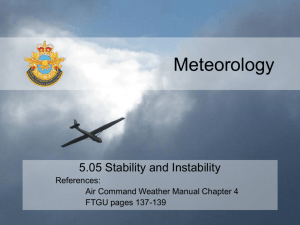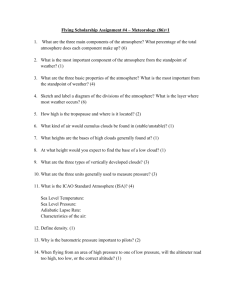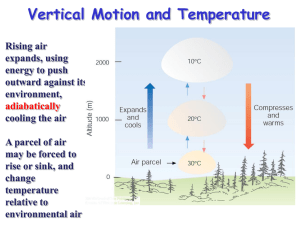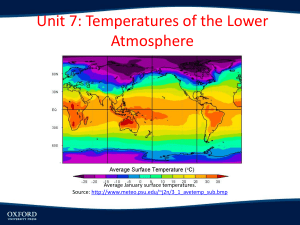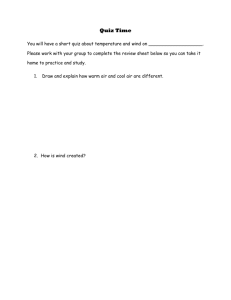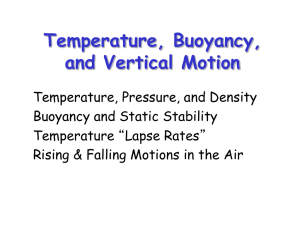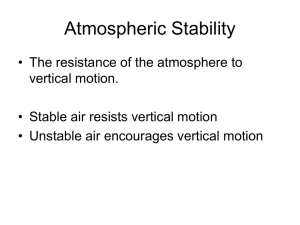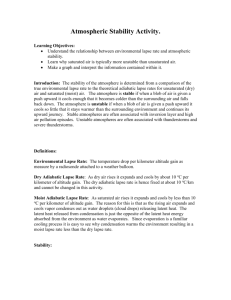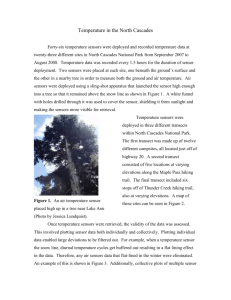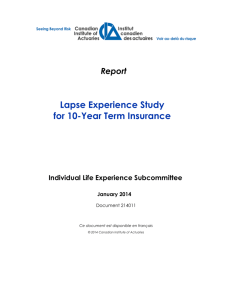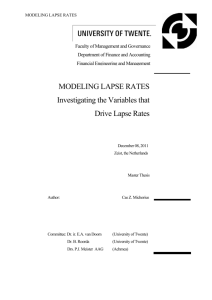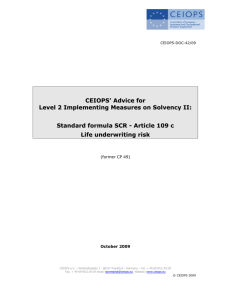5.05 Stability and Instability
advertisement
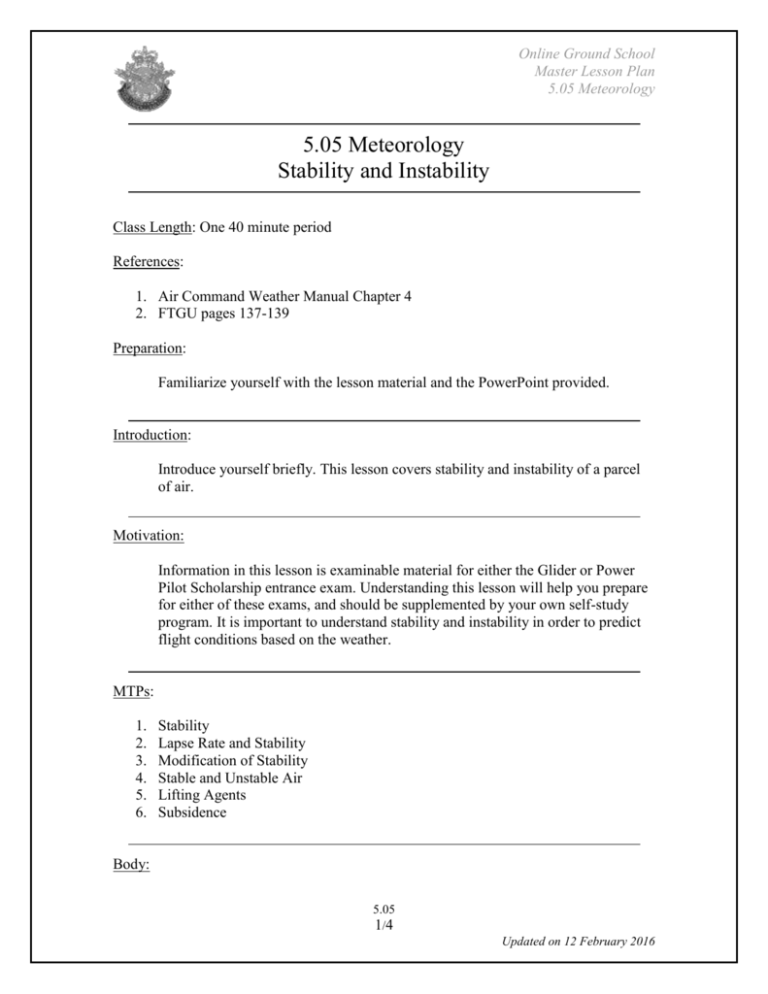
Online Ground School Master Lesson Plan 5.05 Meteorology 5.05 Meteorology Stability and Instability Class Length: One 40 minute period References: 1. Air Command Weather Manual Chapter 4 2. FTGU pages 137-139 Preparation: Familiarize yourself with the lesson material and the PowerPoint provided. Introduction: Introduce yourself briefly. This lesson covers stability and instability of a parcel of air. Motivation: Information in this lesson is examinable material for either the Glider or Power Pilot Scholarship entrance exam. Understanding this lesson will help you prepare for either of these exams, and should be supplemented by your own self-study program. It is important to understand stability and instability in order to predict flight conditions based on the weather. MTPs: 1. 2. 3. 4. 5. 6. Stability Lapse Rate and Stability Modification of Stability Stable and Unstable Air Lifting Agents Subsidence Body: 5.05 1/4 Updated on 12 February 2016 Online Ground School Master Lesson Plan 5.05 Meteorology 1. Stability a. Stability describes what the tendency of a parcel of air is when it is disturbed vertically b. Positive stability i. When disturbed vertically, the air will move back to where it was c. Neutral stability i. When disturbed vertically, the air will continue along where it was moved to d. Negative stability i. When disturbed vertically, the air will move further away from where it was 2. Lapse Rate and Stability a. Unstable air is indicated by a steep lapse rate i. This will create a situation where warm air that is rising will continue to be warmer than the air around it as it rises, expands, and cools at the dry lapse rate. Because it will continue to be warmer, it will continue to rise. b. Stable air is indicated by a shallow lapse rate i. This will create a situation where warm air that is rising will be cooler than the air above it relatively quickly and stop rising. 3. Modification of Stability a. Heating from below will cause instability i. The air will be warmer than that surrounding it, and tend to rise b. Cooling from below will cause stability i. The air will be cooler than that surrounding it, and tend to sink and remain 4. Stable and Unstable Air a. Stable Air i. Shallow lapse rate ii. Stratiform clouds iii. Uniformly intense precipitation, including drizzle iv. Poor low level visibility v. Steady winds which can change with altitude vi. Generally smooth flying conditions b. Unstable Air i. Steep lapse rate ii. Cumuliform clouds iii. Showery precipitation iv. Good visibility, except in precipitation v. Gusty vi. Turbulence may be moderate to severe 4.5 Confirmation Questions a. What are the 3 types of stability? a. Positive, negative, neutral b. What type of stability leads to smooth air? 5.05 2/4 Updated on 12 February 2016 Online Ground School Master Lesson Plan 5.05 Meteorology a. Positively stable c. A shallow lapse rate leads to what type of air? a. Stable air 5. Lifting Agents a. Convection i. Uneven heating of different types of surface 1. Especially differences between areas of land and water ii. Sun heats earth, heat radiates upwards rising currents of air separated by areas of sinking air b. Orographic Lift i. Air moving up a sloping terrain (ex. mountain) will continue its upward movement ii. Unstable air will increase the amount of lift. c. Frontal Lift i. Warm Front 1. Warm air advances on a retreating cold air mass 2. Warm air ascends over the cold air in a long gentle slope ii. Cold Front 1. Mass of cold air advances on mass of warm air 2. Undercuts the warm air, forces it to rise sharply d. Mechanical Turbulence i. Also known as “eddies” ii. Friction between air and ground iii. Irregular terrain and man-made obstacles cause severe eddies iv. Usually confined to lower thousands of feet e. Convergence i. Air flows from high to low pressure ii. Air converges/meets over the centre of the low pressure iii. Excess air is forced to rise. 6. Subsidence a. Occurs in High pressure systems or in air flowing down the side of a mountain b. As the air descends, it reaches regions of increased atmospheric pressure and is compressed i. As a result, its temperature rises. ii. This may trap cooler air below it Confirmation: 1. Name 3 lifting processes. a. Convection b. Orographic Lift c. Frontal Lift d. Mechanical Turbulence 5.05 3/4 Updated on 12 February 2016 Online Ground School Master Lesson Plan 5.05 Meteorology e. Convergence 2. What type of cloud is associated with: a. Stable air? i. Stratiform b. Unstable air? i. Cumuliform 3. Why does a steep lapse rate mean the air will be unstable? a. A steep lapse rate creates a situation where warm air that is rising will continue to be warmer than the air around it as it rises, expands, and cools at the dry lapse rate. Because it will continue to be warmer, it will continue to rise. 4. Good visibility is associated with what type of air? a. Stable Air Conclusion: This lesson covered stability and instability of a parcel of air. It is important to understand stability and instability in order to predict flight conditions based on the weather. Understanding this lesson will help you prepare for a flying scholarship entrance exam, and should be supplemented by your own self-study program. If you have any questions, you can direct them to emailonlinegroundschool@gmail.com. 5.05 4/4 Updated on 12 February 2016
